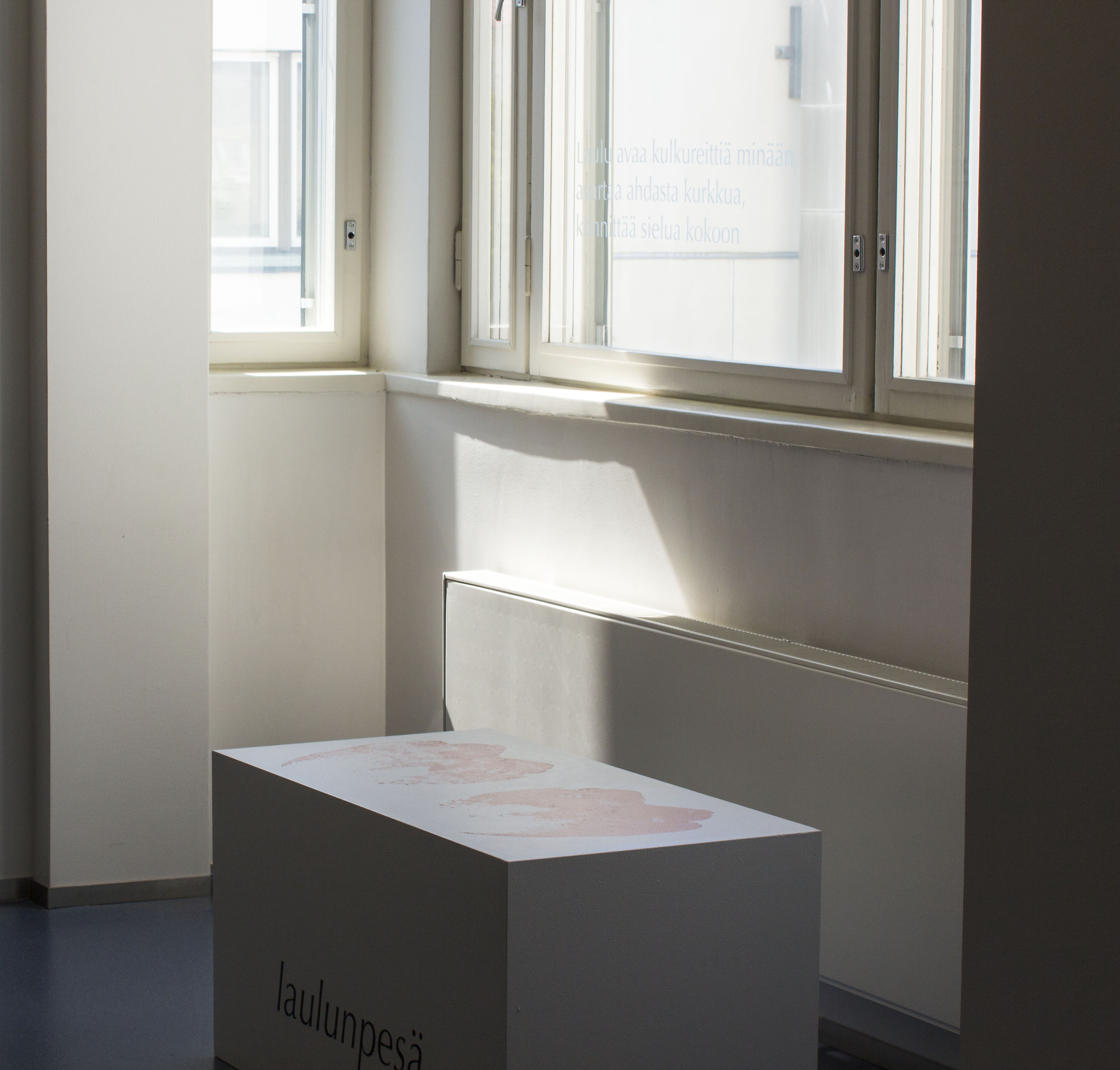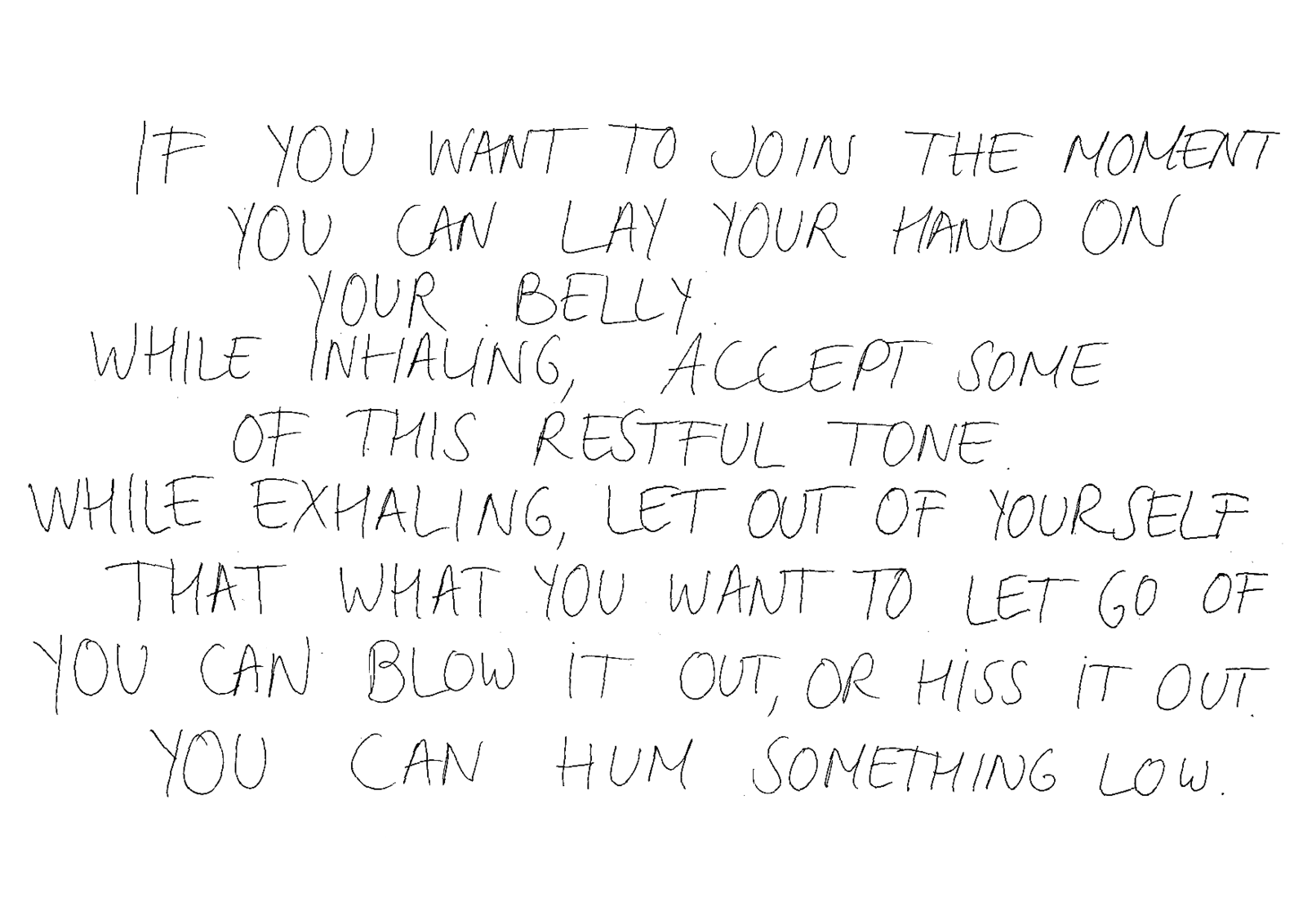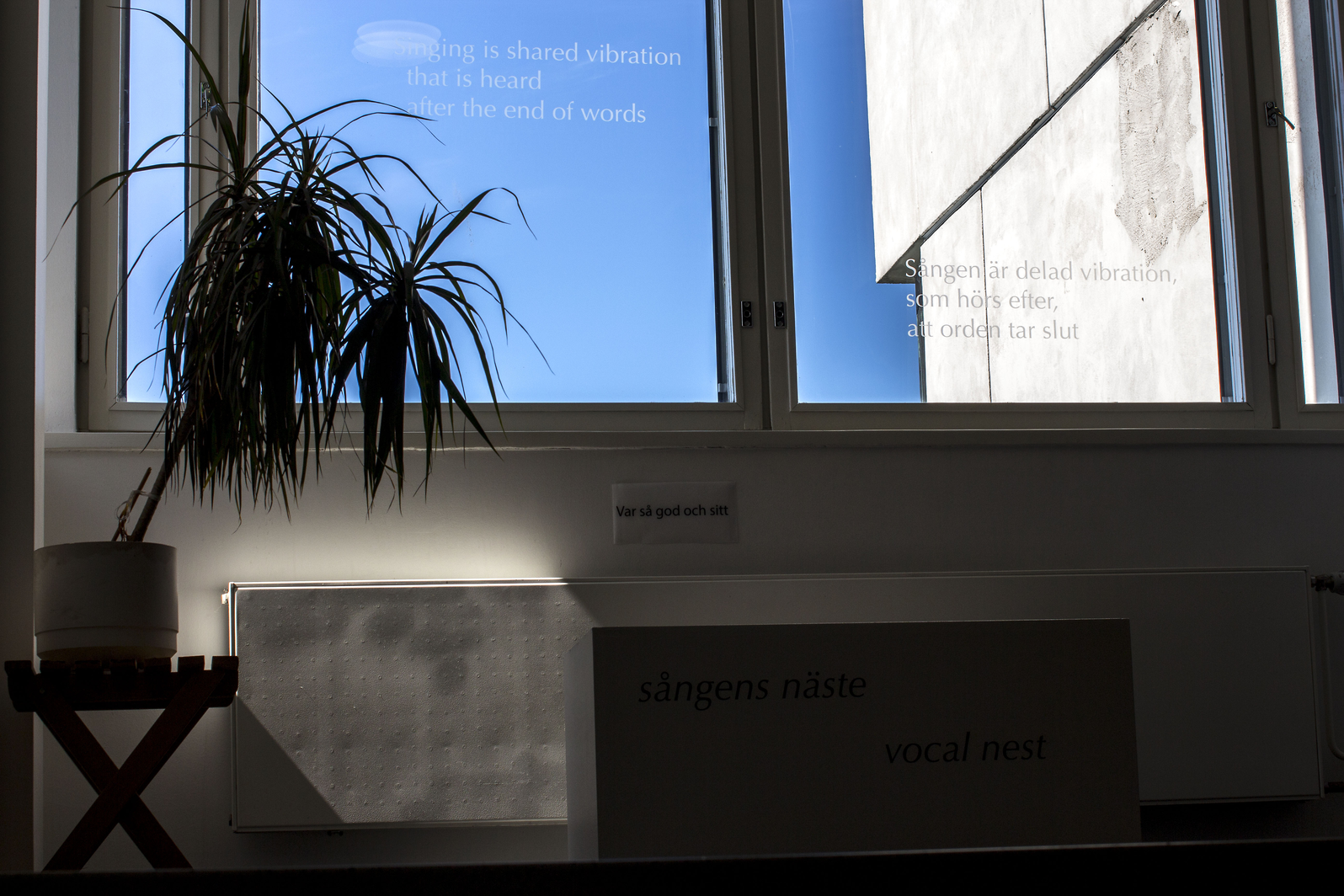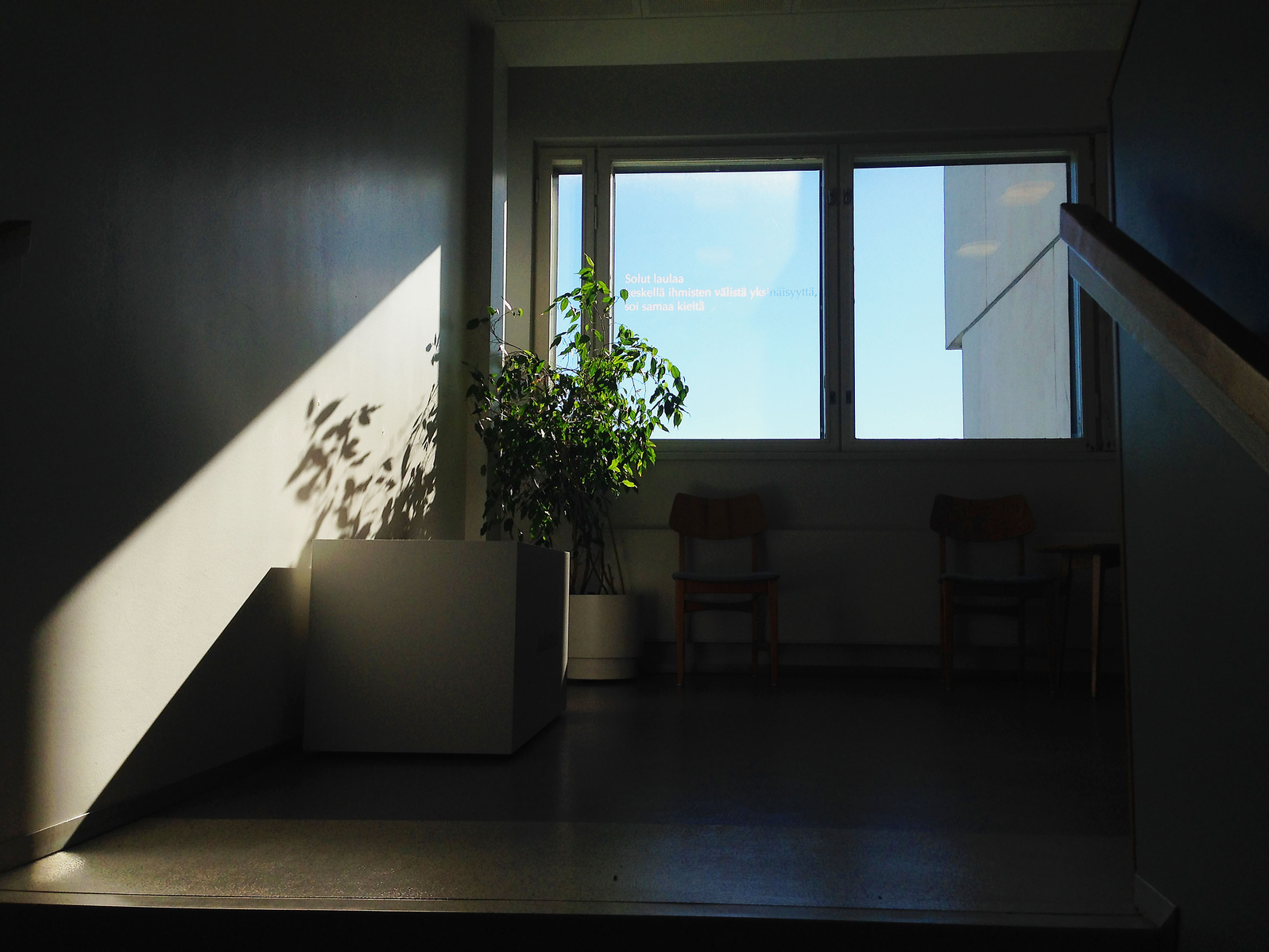Attunement to listening as an atmospheric phenomenon
Perhaps the most palpable way to account for the embodied and affective transitions catalysed by the composition was through the pattern of mutual silence in the hospital stairwell. The ways in which many people attuned to the silent states of listening seemed to invoke a sensitivity that brought about embodied changes, which were felt and noticed by many. But how to talk about the ambiguous phenomenon of attuning to listen, and becoming sensitive to rigorously encountering what one hears and senses? Particularly since this cannot (for the thoroughly in-between quality of the phenomenon) be introduced as an object of knowledge?1 The notion of atmosphere helps to illuminate the specific, affective quality of such an experience of listening as a relation. As one entered the stairwell from the wards, or the main entrance, one was first and foremost faced with the intimate, vibrating atmosphere — not an art object — which people experienced through their bodies and their sensate knowledge. According to Vadén and Torvinen, atmospheric experience precedes the identification of separate entities.2 Anderson argues that ‘affective atmospheres are a class of experience that occur before and alongside the formation of subjectivity, across human and non-human materialities and in-between subject/object distinctions’.3 Such an in-between sphere is collectively available, as Vadén and Torvinen emphasise. However, it needs some human participation for it to affect.4 Consequently, I aim to map the ways in which people composed themselves in relation to this field of resonance in terms of sensate knowledge, and why this apparently embodied relational register might matter. I will enter the material reality of these moments, and the challenging issues that emerge from within, through my own situatedness.
I would like to propose that the transition from the silent zones to vibrating utterances — as well from the everyday linguistic reality of the hospital towards the composition’s vocal, non-verbal expression — attuned a new kind of default sensibility to the hospital space. It invited a pause that enabled transition to a dwelling mode of listening. It appeared intangibly/tangibly, as varied combinations of people (patients, nurses, doctors, priests, relatives, and administrative staff) inhabited the stairwell in a rhythm, which differed from the transitory usage of the space. The entangled sounds, that is, the varied energetic compositions and embodied frictions, started to unfold into the stairwell. Their intention was not to transform information. They did not describe, but rather invoked. Despite their acute forms of suffering, people listened for the most part in complete silence, sitting or standing together. I did not know the exact diagnoses of the psychiatrically disabled people, but I knew that within the closed wards some people might be suffering from, among other things, psychotic experiences, deep depression, or geropsychiatric situations. Many people had closed their eyes. The atmosphere of these moments was, without exception, always moving and haunting.
This kind of an openness in a listener calls for a certain level of fragility. It reminds one of the philosopher Jean-Luc Nancy’s understanding of listening as a simultaneous openness from the inside and outside spaces of a body.5 The quality of non-verbal vocalising entails a similar kind of embodied vulnerability. Through non-verbal vocal expression, something is immediately revealed and emanated into the surrounding space. That is, vocal utterances make someone perceptible in her corporeality, as Böhme claims, because they are characteristically moulded by, yet exceed by, the body they emanate from. The reason why we are affectively influenced by voice, he continues, ‘is that the voices we hear modify our own bodily existence in space.6 The radicality of such tones is that they compel the listener to listen rather through her body than through language and reason.7 For such a resonance field to reach the listener, and for it to matter to her or him, it needs some sensate support: an agency of actively letting the voice vibrate and resonate, to hit the shared reality between the subject and object in an unpredicted way. With such listening, the listener releases her-/himself to the resonance and may therefore be struck by acoustic events. As Vadén and Torvinen point out, this kind of atmospheric listening is ‘not necessarily common or easy to maintain’, but it might enable an immanent experience of connection.8
Berardi’s theory of sensibility offers an interesting reference point. According to him, the faculty of sensibility makes it possible for human beings to enter empathic relations. He argues, however, that the current socio-political situation has directly impinged upon our abilities to relate with the surrounding reality. The root causes of this crisis are brought about (to cite Berardi): by the ‘digital abstraction [that] leads to the virtualization of the physical act of meeting’ and by semio-capitalism capturing the inner resources of subjectivity at the deep level of perception. The effect is primarily targeted, he claims, at weakening our abilities to relate to each other and feel compassion. The argument is not difficult to grasp in the contemporary atmosphere of fear and distrust. Berardi highlights the significance of embodied conjoinment.9 While direct causal relations between the macro level of (assumed) societal transformations and the micro level of a singular participatory artistic process cannot be made, some tentative intra-actions could, however, be proposed. When the process of Vocal Nest is examined as sensate knowledge, it was understood that the vocal work and the attuned atmosphere between the vocalising and listening bodies opened a sensate sphere of contact within the hospital space. Within its sphere of influence, new routes for communication were generated. That is, the creation of participatory passages to the sensate dimensions of experience seemed to stir up a different pattern of human agency and sensibility within this particular environment. This approach differs from the current emphasis in Finnish psychiatric care, which - along with an increasing share of outpatient treatment - is strongly focused on treating individuals as such. The atmospheric mood of the stairwell, on the other hand, opened a parallel register besides this approach: it rendered audible and tactile the significance of communality within psychiatric care. While attuned to listening to the ineffable relational register, people also seemed to express quite enlivened abilities to attune with the surrounding non-verbal sphere, and create connection on an empathic level. When something happens to people within this field of experiencing and feeling, society is altered.
This sensibility was evident in people’s embodied reactions and emotionally moved affectations. Some people were moved to tears while listening, and this led to a reorganisation of new kinds of agencies between them. For example, there was a moment when a person receiving treatment in one of the wards became emotionally moved. Another person paid attention to her and went to embrace her silently. The philosopher Juha Varto writes about a state of reverence, within which one returns to her or his natural sensitivity to sense, hear, and see the world. This kind of sensibility is a matter of the senses, the whole embodied being. To encounter the world within in such a vulnerable state, through such a sensibility, can hurt.10 Similar themes were also pointed out by some of the listeners. Somebody had written an anonymous feedback from the installation in the music hall of the Psychiatry Centre: ‘How beautiful and soothing can voice be. Resonates deeply. A unique atmosphere here in the hall, sensitive, silent, receptive, and shared with others. One could stay here, but I leave being sensitized’.11
As the vocal sounds quieted in the stairwell, the mood among the several people gathered in the hallway from one of the wards ended with a minute or so of deep mutual silence. Nobody moved or spoke. The affective quality of this silence differed from the more isolated quietness, described above. It appeared to me as a sense of connection, communicated by tactile and vibrational sensations of certain restfulness that I could sense in my body. The shared silence echoed evidence that the attunement to listen is a thoroughly embodied, spatial and atmospheric phenomenon: a shared affective space. According to Vadén and Torvinen, such an encompassing quality of a resonant atmosphere cannot be objectively measured, but is experienced as an affective consternation.12 This affective change was also noticed by some of the staff members. At these moments, the silence also interacted with the everyday sounds of the hospital in a different manner, which were now composed within a new kind of experiential frame. One could claim that, at the point of mutual attunement to listen, Vocal Nest operated similarly to a medium, which to cite the philosopher-artist Esa Kirkkopelto, not only enabled the change, but made it happen ‘in a certain way, according to the conditions set by the mediating material or technique’.13 To elaborate further, the atmosphere of the composition was then not simply a feature of the artwork. It was rather attuned as a vibrating interval between the listeners’ subjective sensibilities and the objective qualities of the piece, insofar as the artistic modification of the hospital space was experienced by their bodies.14
Yet, when listening from a diffractive position, in its call for attentive and attuning listening, the composition was also challenging. While insisting on a more lingering pace within the stairwell, it interfered with the temporal emergence that is typical in the everyday life and rhythms of the hospital. This was experienced as discomforting by some people. According to Vadén and Torvinen, ‘one senses the specific nature of the atmosphere most clearly when different atmospheres are set apart from each other’.15 The limits of mutual silence were revealed when the withdrawal back into daily routines occurred: into the atmosphere of language, to another rhythm and tone of speech, which again revealed the traditional medical relationships of staff and inpatients. Some of the staff members felt that the short passage in the stairwell, in the affective sphere of the artwork (it was not audible in the wards), was somewhat distressing. In the middle of the challenging and acute work, it was perhaps not even possible to immerse oneself in the slowly emerging pace of the artwork. Some other staff members, however, experienced this very point of friction between two atmospheres as beautiful. It helped them to see their work, and the people they work for, in a new light: as one of them stated, ‘immediately when I arrive here [into the stairwell], I can remember why I do this [work]’.16
So, what is at stake here? In light of the sensate knowledge described above, I propose that the delicate and gradual transitions of an atmospheric mode of listening revealed a whole new kind of ineffable, embodied communion within this particular material-discursive environment. In discussing why vocal art encounters within the context of a psychiatric institution might matter, and what those encounters might add to this institution, it is crucial to acknowledge that the embodied experience of art in a care environment already matters in itself. Let me elaborate. In my previous article, I proposed that the shared act of non-verbal vocal attunement between the participants of Vocal Nest could be seen as an archaic mode of conjunction. Such rudimentary expressions of relationality may perhaps be heard in the compositional elements within this exposition. This argument seeks a new kind of interpretation of the comprehension that a subject suffering from a psychiatric disability could only be tenuously, if at all, present within the scope of social interaction.17 The radical intimacy of the listening situation seems to argue for a similar hypothesis. Vocal Nest, however, revealed something of humans’ ability for conjoinment, even at a moment of psychical crisis: someone who does not interact verbally to any significant degree, and who might seem, from some perspectives, to be un-relational, might feel a profound sense of connection to others via the shared attunement to listening together.



